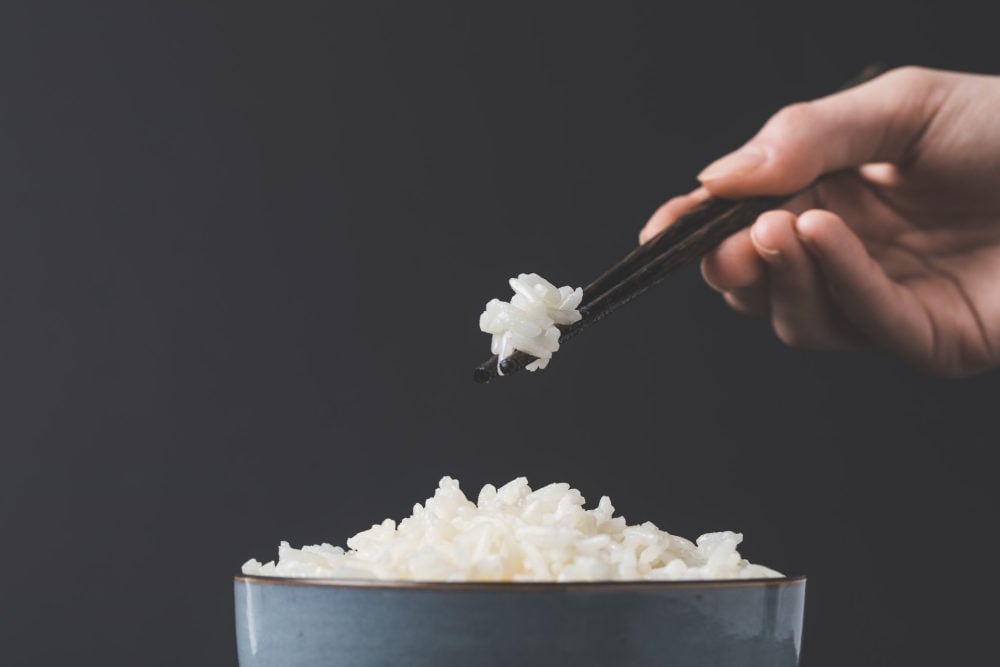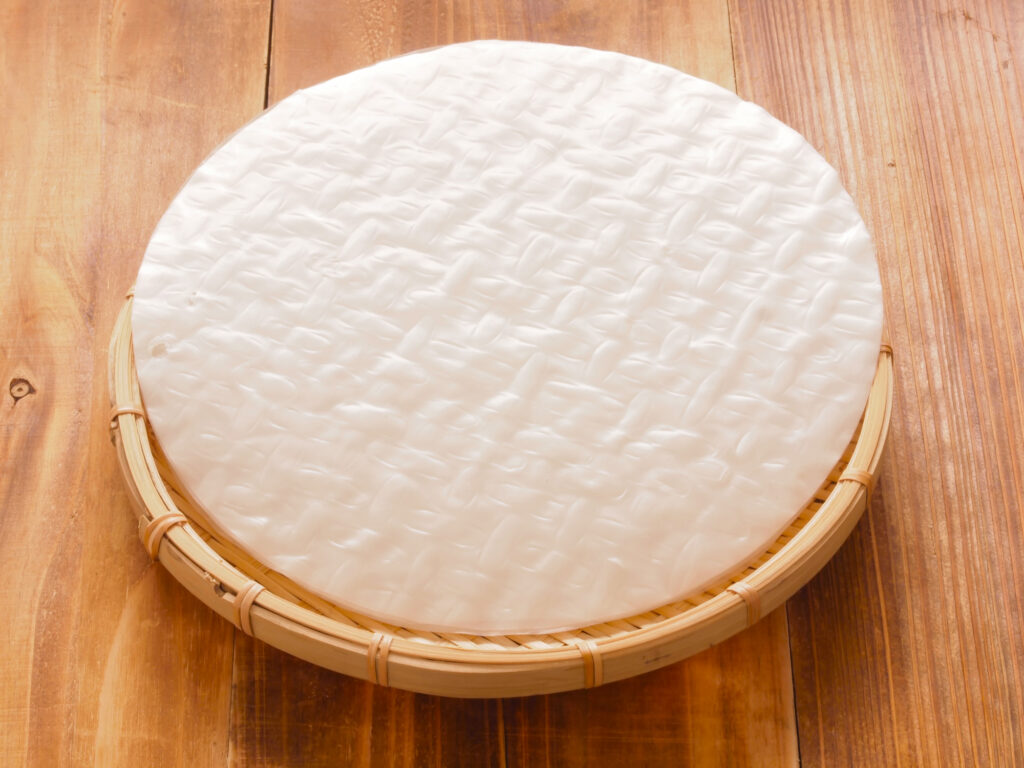
Many people wonder if rice is gluten-free and if it can be safely enjoyed by those following a gluten-free diet. I’ll answer all your burning questions about rice and gluten. This post contains affiliate links. Please see my disclosures here.
Years ago, I went to a catered networking luncheon. I contacted the organizers to request a gluten-free meal (if possible). They said it would be no problem.
When I arrived, they said I could enjoy the fish and vegetables, but they told me to avoid the rice. Stumped by this warning to avoid the rice, I inquired further. I knew rice to be naturally gluten-free. Perhaps they put something gluten-y in there?
As it turns out, they didn’t put anything in the rice. They told me to avoid it because they thought rice contained gluten.
I explained to them that rice does not contain gluten and that rice is gluten-free. In fact, rice is a staple ingredient in most gluten-free flours, baked goods, and more.
Given the confusion those in the professional catering industry hold regarding rice, I thought I would write this article to set the record straight about rice, mochi, mirin, Minute Rice, glutinous rice, and everything in between.
Is Rice Gluten-Free?
Yes, rice is naturally gluten-free. This goes for all types of rice:
- White rice – yes, it’s gluten-free!
- Brown rice – yes, it’s gluten-free!
- Jasmine rice – yes, it’s gluten-free!
- Arborio rice – yes, it’s gluten-free!
- Basmati rice – yes, it’s gluten-free!
- Black rice – yes, it’s gluten-free!
- Wild rice – yes, it’s gluten-free!
- Sushi rice – yes, it’s gluten-free!
Is Rice Flour Gluten-Free?
Yes, white rice flour, brown rice flour, and sweet rice flour are all gluten-free. In fact, many baked goods are made with rice flour as the primary ingredient.
Is Glutinous Rice Gluten-Free?
Yes, glutinous rice, or sticky rice, is gluten-free. Glutinous, which sounds like the word gluten, simply refers to the stickiness of the rice, not the protein known as gluten. Confusing, I know!
While gluten is off-limits to those with celiac disease or gluten sensitivities, glutinous rice is okay to eat and is 100 percent gluten-free.
Is Rice Paper Gluten Free?
Yes, rice paper (also called nem wrappers) is made from rice starch and is edible. The only ingredient in rice paper is rice, although check labels because some rice paper may include tapioca starch or other ingredients. (Tapioca starch is gluten-free, too.)
To reconstitute rice paper, you simply dip it in warm water, then use it to wrap spring rolls or my deconstructed egg rolls.

Is Mochi Gluten-Free?
Mochi is a soft and gummy-like Japanese rice cake made from mochigome, a short-grain japonica glutinous rice (sweet rice flour or mochi flour). Other ingredients, such as water, sugar, and cornstarch, are used to make mochi too.
When making mochi, the rice is flattened into a doughy paste, formed into the desired shape, and stuffed with a sweet red bean paste or ice cream. Mochi is a very popular treat in Japan.
While mochi is gluten-free, check labels as some manufacturers add wheat or other ingredients to store-bought mochi treats.
Is Mirin Gluten-Free?
Mirin is a Japanese rice wine that infuses savory umami flavor into Asian cuisine. It’s commonly used as a marinade or dipping sauce in popular Asian dishes.
Mirin is made from fermented sweet rice and is naturally gluten-free. Always check labels to ensure no other questionable ingredients have been added.
Is Rice-A-Roni Gluten-Free?
No, Rice-A-Roni is not gluten-free because it contains rice and pasta (orzo, vermicelli) made from wheat flour. Below is the company’s official statement:
We understand that individuals sensitive to gluten may have difficulty digesting even trace amounts of gluten. Since so many of our Rice-A-Roni and Pasta Roni products contain grain ingredients that have gluten, we cannot guarantee that any particular product is entirely free of gluten.
Pasta Roni is not gluten free as it is made from wheat flour.
Rice-A-Roni products also include wheat flour because they combine pasta such as orzo, vermicelli, etc. with the rice. Even Rice-A-Roni products that do not combine rice and pasta may possibly contain trace amounts of gluten because they are made in the same facility as products that include wheat flour and other grain ingredients.
-Rice-A-Roni website
The good news is that while Rice-A-Roni is off-limits, several brands are free from gluten, including:
Is Zatarain’s Rice Gluten-Free?
Many of Zatarain’s boxed rice mixes are labeled gluten free, including its yellow rice mix. Read individual labels to identify ones that are free from gluten.
Is Minute Rice Gluten-Free?
Several Minute Rice boxed rice is gluten-free, according to the manufacturer, including its brown rice, jasmine rice, rice, and quinoa mix, and many of its ready-to-serve rice, including the ready-to-serve yellow rice.
(And yes, before you ask, quinoa is naturally gluten-free like rice. Read 27 Tried and True Quinoa Recipes.)
Is Uncle Ben’s Gluten Free?
Many of Uncle Ben’s rice mixes are naturally gluten-free. Always check ingredient labels to ensure the exact mix you’re purchasing is gluten-free.
Are Rice Krispies Gluten-Free?
No, Rice Krispies are not gluten-free. Although they are made from puffed rice, Kellogg’s coats them with barley malt. There are crispy rice cereal options that do not contain gluten. You can learn about them in my article, Are Rice Krispies Gluten Free?
Is Risotto (Aborio) Rice Gluten-Free?
Yes, risotto rice is gluten-free. Risotto is typically made with arborio rice, short-grain starchy rice. This vegetable risotto recipe, for example, uses arborio rice. Of course, risotto is a dish that contains many ingredients that may or may not be gluten-free. Inquire within.
Are Chow Fun Noodles Gluten-Free?
Chow fun noodles are wide, flat rice noodles in many Chinese dishes. They are typically gluten-free and contain only rice. Chow fun noodles are delicious and have a wonderful texture that I love. I almost always order chow-fun rice noodles when given the option.
When ordering chow fun at a Chinese restaurant, beware of how it’s prepared and seasoned. Most restaurants typically season chow-fun noodles with soy sauce, which is not gluten-free.
Is Bulk Bins Rice Gluten-Free?
Always buy rice found in sealed packaging and where the only ingredient is rice (unless the words “gluten-free” are noted somewhere on the packaging).
Bulk bins are notorious for cross-contact with the items in the other bulk bins, which may contain gluten. People often mix up bulk bin scoops, or some bulk bins spill into the other bins. For example, this becomes tricky when the rice bulk bin is directly below or next to the shredded wheat bulk bin.
Eating Rice at Restaurants
When eating rice at restaurants, ask how it’s cooked to ensure it is free from gluten-containing broths, soy sauce, or other ingredients that would render it no longer gluten-free.
Be sure to ask lots of questions, express the seriousness of your diet, and study up on my tips for eating out safely.
Rice is often served at Chinese restaurants and mixed with soy sauce in fried rice. Therefore, most restaurant fried rice dishes are not gluten-free. (Try my homemade gluten-free egg fried rice recipe, though.)
Sushi rice, however, is made with glutinous sticky rice, rice wine vinegar, and sugar, which is safe for you to eat (of course, make sure no other ingredients are added to the rice, and that the sushi toppings are free from soy sauce). Imitation crab is also a no-no at most Japanese restaurants.
Related Article: How to Make Gluten-Free Sushi Rolls
Mexican restaurants often serve seasoned Mexican rice or Spanish rice that is typically free from gluten. However, inquire within to make sure no gluten-y seasonings or add-ins were used.
Related Article: How to Avoid Gluten at a Mexican Restaurant
Is there Arsenic in Rice?
Gluten-free eaters eat more rice and are often exposed to higher levels of arsenic.
Arsenic is an element in the Earth’s crust and is present in our water, air, and soil. The FDA says that rice contains higher levels of inorganic arsenic because the grain tends to absorb arsenic more readily than other crops. On top of rice being a natural element found in the earth, arsenic is also sprayed on our crops, which leaches into the ground soil and is absorbed by the rice.
Consumer Reports tested different rice varieties to determine which rice has the lowest and highest arsenic contents.
Researchers found that white rice generally contains less arsenic than brown rice (as the arsenic is found in the outer husk, which is removed in white rice). In fact, brown rice has 80 percent more inorganic arsenic on average than white rice of the same type. However, brown rice has more nutrients, so ditching brown rice isn’t the best choice either.
They also found that white basmati rice from California, India, and Pakistan and sushi rice from the U.S. have about half the inorganic-arsenic amount of most other types of rice.
Conversely, the researchers found that white rice from Texas, Arkansas, and Louisiana contains the highest levels of inorganic arsenic.
To ensure lower exposure to arsenic, experts suggest that you rinse your rice thoroughly before cooking (several rinsings). They also recommend cooking your rice in excess water and draining it to drain off excess arsenic.
Also, instead of eating rice, researchers suggested that gluten-free eaters enjoy alternative grains, such as quinoa (technically a seed), millet, and buckwheat, all of which contain less arsenic than rice.
Rice is Nice
While rice is nice to eat when you’re on a gluten-free diet, enjoy it in moderation. Fill your plate with plenty of fresh fruits and vegetables, lean meats, potatoes, beans, and other grains, like buckwheat, millet, and quinoa.
Related Article: The Celiac Disease Diet: What A Celiac Can and Can’t Eat
The good news is that it’s perfectly safe to enjoy rice following a gluten-free diet. Enjoy the delicious grains in moderation … and always read labels to uncover hidden gluten.
Leave a Comment